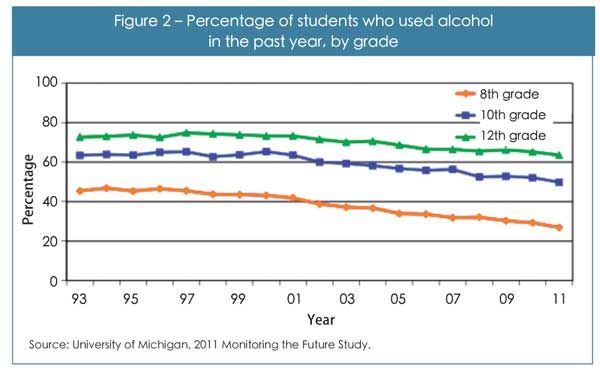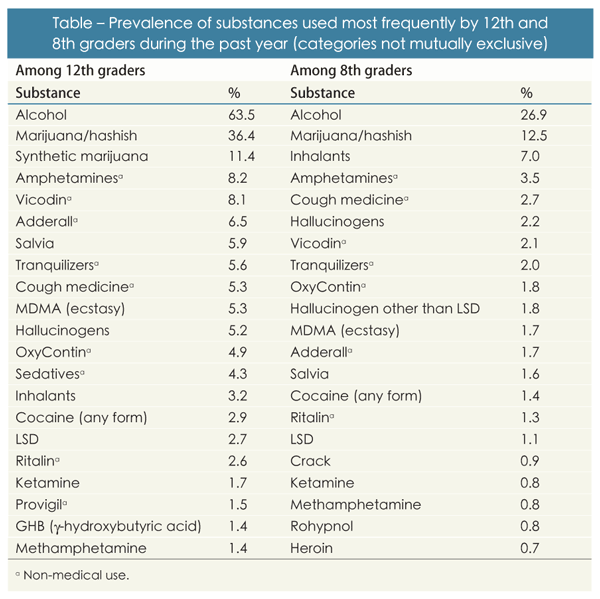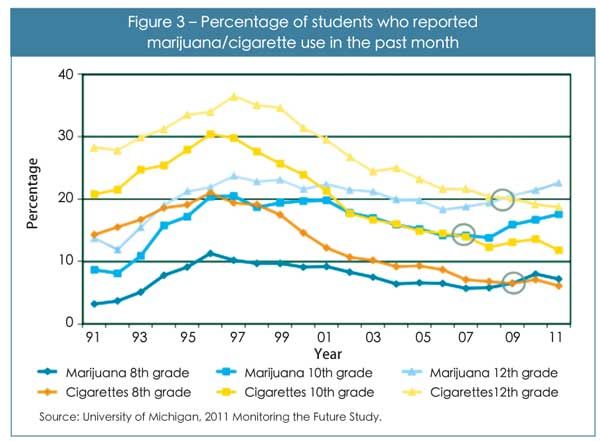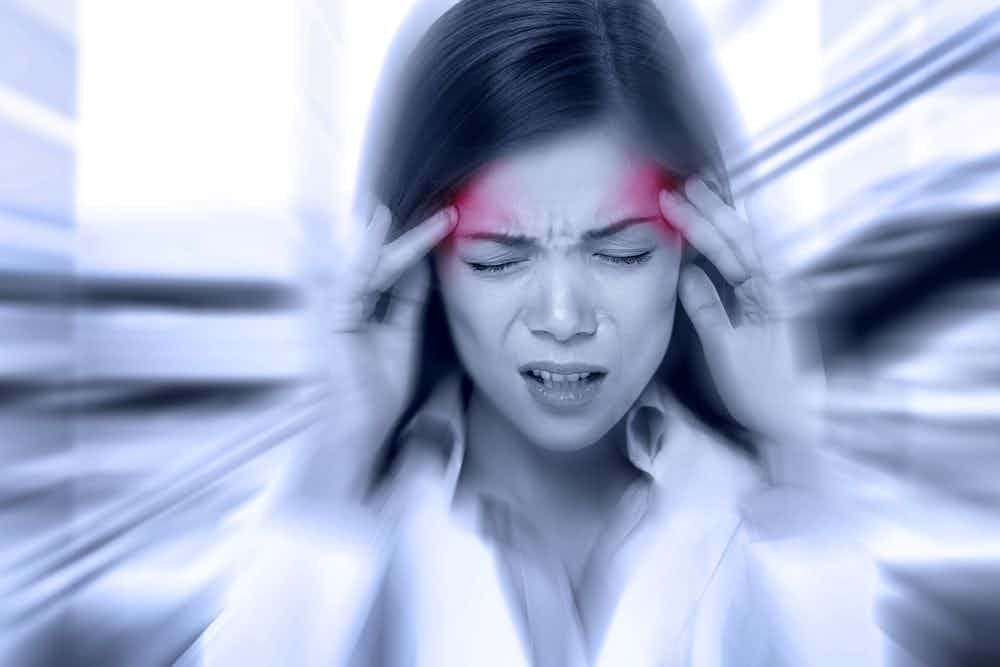Publication
Article
Psychiatric Times
Epidemiology and Treatment of Substance Use and Abuse in Adolescents
Author(s):
This article covers the spread of substance use problems in adolescents and some of the currently available scientifically proven behavioral treatments for these conditions.
Figure 1 – Percentage of students who used illicit drugs in the past year, by grade

Figure 2 – Percentage of students who used alcohol in the past year, by grade

Table – Prevalence of substances used most frequently by 12th and 8th graders during the past year (categories not mutually exclusive)

Figure 3 – Percentage of students who reported marijuana/cigarette use in the past month

CME credit for this article is now expired. It appears here for your reference.
This article covers the spread of substance use problems in adolescents and some of the currently available scientifically proven behavioral treatments for these conditions.
Three main points need to be highlighted.
• First, experimentation is a normal behavior during adolescence; however, drug use is not, nor is the transition into drug problems. Experimentation with drugs and alcohol is fraught with risks and should be discouraged. Particularly, data suggest that the younger the age that substance use is started, the higher the risk for substance dependence.
• Second, drug use starts primarily as a social behavior, concurrent with the social reorientation from family to peers that takes place during adolescence.
• Third, the adolescent brain undergoes unique changes that contribute to enhancing impulsivity and risk-taking behaviors, which are vulnerabilities for substance use. These behaviors serve to facilitate the transition that adolescents need to accomplish for species survival-leave the nest and confront a new and potentially dangerous world to become independent.
Much work has been dedicated to understanding the neural changes that underlie risk for substance use problems in youths, as well as the effects of drug addiction on the adult brain. (Very little has been done on the adolescent brain.) Implications for treatment that will refine existing effective interventions and provide new therapeutic strategies are yet to come.
Epidemiology
In the United States, estimates of adolescent substance use behaviors and attitudes primarily come from 3 population-based national surveys: the Monitoring the Future (MTF) study of 8th, 10th, and 12th graders and linked longitudinal follow-up studies; the National Survey of Drug Use and Health (NSDUH) study of those aged 12 and older; and the Youth Risk Behavior Survey of adolescent students.1-3 These surveys employed different methods and produced slightly different point estimates, yet the trends of adolescent substance use over time are consistent across the surveys. Only the most notable estimates are presented.
Drug use starts at different ages, depending on the type of substances, but generally onset is in adolescence. Findings from the MTF study indicate an earlier start for drugs that are perceived as less harmful or risky and for those that are easily accessible. Earlier start patterns were reported for alcohol, tobacco, and inhalants (more than half of users reported initiation before the end of 9th grade) relative to other illicit drugs, such as cocaine and hallucinogens (fewer than one-third reported initiation before the end of 9th grade).1
Among respondents in the NSDUH study who reported using an illicit drug for the first time in the past year, more than half were younger than 18.2 These estimates of school samples are based on retrospective reports and may not capture those heavier users who dropped out of school.
Adolescent substance use peaked in the mid to late 1990s. This peak was followed by a general decline, despite some geographic and drug-specific epidemics, until around 2008, when the overall decline seems to have stalled. In 2011, according to the MTF study, nearly half of high school seniors reported having used an illicit drug at some point, and 40% had used in the past year (Figure 1), followed by 33% of 10th graders, and 15% of 8th graders. Marijuana was the most prevalent illicit drug. Nearly two-thirds of high school seniors, half of 10th graders, and more than 26% of 8th graders reported taking at least 1 drink in the year before the survey (Figure 2), and more than 42%, 29%, and 10%, respectively, had been drunk.
Patterns of drug use may vary by sex and ethnic group as well as by drug type. Boys tend to report more use than girls, particularly as they get older and for many different drugs.1 Boys may have greater opportunities to initiate drug use than girls; however, when opportunity to use was controlled for, boys and girls were equally likely to use.4 White and Hispanic adolescents tend to report more overall drug use than African American youths; however, differences vary by drug type and school grade.5 Additional details regarding racial and ethnic differences can be found in the respective reports of the 3 surveys.
The surveys showed an increasing prevalence of use of the majority of substances among older students. Inhalants were the exception: 7% use was consistently reported by 8th graders versus 5% and 3% for 10th and 12th graders, respectively.1 The Table shows the substances reported most frequently by 12th and 8th graders. After alcohol and marijuana, 12th graders reported alarmingly high rates of synthetic marijuana use (eg, K2, Spice), and 8th graders (who were not asked about synthetic marijuana) followed with inhalants.
Both grades are similar in that many of the substances most frequently abused are prescription or over-the-counter medications. These primarily include powerful opioids that are often used concurrently with other substances.6 The prescription medications, diverted for non-medical use, come from friends or relatives for whom the medications were prescribed. This has a critical implication for pediatricians, general practitioners, and child psychiatrists who need to be extremely vigilant when prescribing abusable drugs, particularly for adolescents.
Clinicians should systematically warn and guide all patients about safe medication management and storage-even those for whom they are not prescribing.
After peaking in the mid-1990s, adolescent cigarette use has declined steadily to historical lows.1,3,7 However, given the addiction potential and well-established morbidity and mortality associated with tobacco use, the fact that 1 in 10 high school seniors still smoke is of concern. Other types of tobacco use have become more mainstream, including hookah smoking and use of dissolvable or chewing tobacco products that adolescents may perceive as less harmful than regular cigarette smoking. For the first time, youths report more marijuana use than cigarette use. Figure 3 shows the trends of cigarette and marijuana use over the past 20 years among 8th, 10th, and 12th graders.
The risk estimates of substance use/disorder have consistently been found to be 3 times more likely in youths with a psychiatric disorder than in those without a psychiatric disorder.5 The most prevalent co-occurring disorders are conduct disorder, depression, anxiety, and certain personality disorders; some evidence suggests psychotic disorders as well. However, the direction of many of these relationships is still unclear. The long-term outcomes and costs underscore the need to understand the relationship between substance use/disorders and psychiatric disorders, rather than treating them as individual and separate conditions.
In contrast to studies of adolescent substance use, there is much less information on adolescent substance use disorders. A recent NSDUH study found that roughly 7% of 12- to 17-year-olds surveyed had a diagnosable alcohol or drug disorder (ie, DSM-IV abuse or dependence on illicit drugs); this figure is down slightly, from 9% in 2002.8 Several regional or local epidemiological samples have reported estimates of adolescent substance use disorder between 1% and 24%, with a median of 5%, depending on age.9 As the clinical community moves toward DSM-5, there is a drive to incorporate the severity of conditions into the diagnosis of substance use disorders (eg, number of symptoms). An understanding of severity might be particularly helpful for adolescent addiction medicine and for defining a threshold for initiation of treatment.
Treatment of adolescent substance use/disorders
Only a small percentage of youths with substance abuse or dependence issues receive substance abuse treatment. In 2010, 8.4% of the 1.2 million American youths aged 12 to 17 in need of treatment for illicit substance abuse received some form of specialized treatment.7 An even smaller percentage of these youths received scientifically supported behavioral treatments.10 A number of factors contribute to this treatment gap. Many substance-abusing youths do not perceive a need for treatment, and parents often underestimate the extent of abuse. Although guidelines urge annual screening, brief interventions, and referral to treatment, these recommendations are rarely followed.
Marijuana is the most used illicit substance.1 Not surprisingly, 73% of youths admitted for drug abuse report marijuana as their primary substance of abuse.2 However, because the majority of individuals admitted for drug abuse treatment report the use of multiple substances, treatments are typically designed for polydrug use. Most treatments shown to work for adolescent drug abuse have been family-based therapies, although a few combination treatments have shown promise. A number of these therapies are highlighted below. (For a comprehensive review of adolescent drug abuse treatments, please see Winters et al,11 Macgowan and Engle,12 Rowe,8 and Waldron and Turner.13)
Family-based therapies. These treat drug abuse indirectly, by improving family functioning and directly by affecting each system in which the adolescent functions (eg, family, school, extracurricular activities).
Multisystemic therapy (MST) is an individualized, intensive, home-based treatment program that focuses on family, school, neighborhood, and the social network factors that contribute to antisocial behavior.14 The ultimate goal of MST is to improve family functioning and leverage these improvements to facilitate healthy and sustainable changes in the youth’ environment. MST has a strong evidence base for treatment efficacy.15-17 Not only does MST decrease drug use, but it also decreases days in out-of-home placement, violent crimes, and criminal arrests.16 Research has also shown that MST in conjunction with drug court may enhance substance use outcomes for alcohol and marijuana and that treatment fidelity may be linked with decreases in drug use and improvements in other substance-related outcomes.17
Multidimensional family therapy (MDFT) is a comprehensive and multisystemic family-based, outpatient program. MDFT targets 4 domains18:
• The youth alone and with family and peer group
• The parent alone and within the family context
• Family functioning
• The interactions between family members and key social systems
Studies have shown the efficacy of MDFT in reducing substance abuse, improving school performance, and improving family functioning in polydrug users as well as in marijuana-only and alcohol-only users.19-22 The reductions in substance use have been maintained up to 1 year following treatment for high-risk early initiators and for youths involved in the juvenile justice sys-tem. Furthermore, findings suggest that MDFT may be particularly useful in treating persons with high severity and frequency of use and those with comorbidity.22 (See Liddle23 for an overview and review of research on MDFT.)
Brief strategic family therapy (BSFT) targets self-sustaining changes in the family environment.24 The main therapeutic techniques fall into 3 categories:
• The therapist initially joins the family by encouraging family members to behave as they normally would while the therapist is present
• Repetitive patterns of family interactions are determined
• Family dynamics are restructured to promote new, more adaptive patterns of interaction
The primary goals of BSFT are to eliminate or reduce the adolescent’ use of drugs and associated problem behaviors (symptom focus) and to change the family interactions that are associated with the adolescent’ drug abuse (system focus). In addition to proven efficacy for drug abuse treatment for youths, BSFT is associated with high levels of engagement of family members and with improving conduct problems, delinquency, and family functioning.25,26
Motivational enhancement therapy (MET)/cognitive-behavioral therapy (CBT) is a combined treatment package.27,28 The initial sessions include MET, which aims to elicit intrinsic motivation to change substance abuse by resolving client ambivalence. CBT follows, with a focus on helping individuals become abstinent. The underlying assumption of CBT is that learning processes play an important role in the development and continuation of abuse and dependence, and that these same learning processes can be used to help individuals reduce their drug use.
Conclusion
While prevention efforts have made strides in curbing substance use/disorders in adolescents, rates continue to be at unacceptably high levels, with excessive alcohol use among a group for whom it is illegal and dangerous followed closely by marijuana use and abuse of prescription medications. Progression of substance use to disorder is commonly associated with the presence of other psychiatric disorders. Therefore, psychiatrists need to be highly aware of the potential substance use problems in their assessment and treatment of adolescents. In addition, given that prescribed medications are among the most commonly abused drugs, clinicians need to be extremely cautious in prescribing for adolescents any medications with abuse potential. In addition, parents should be warned about the need to be vigilant in securing and disposing of their own medications.
Progress has been made in the development of effective drug treatments. However, more work is needed in the areas of community-friendly research (to develop or modify interventions for real-world settings) and in dissemination and implementation of evidence-based treatments into the community, including the education, medical, and legal sectors.
Acknowledgment-We wish to thank Nevia Pavletic for her help in manuscript preparation.
Note: This article was originally published as a CME in the June 2013 issue of Psychiatric Times. Portions of it may have since been updated.
Disclosures:
Dr Chambers is Health Scientist Administrator, Behavioral and Integrative Treatment Branch, National Institute on Drug Abuse (NIDA); Dr Lopez is Branch Chief, Epidemiology Research Branch, Division of Epidemiology, Services, and Prevention Research, NIDA; and Dr Ernst is Head of Neurodevelopment of Reward Systems, National Institute of Mental Health, National Institutes of Health, Bethesda, Md. The authors have no disclosures to report. Sharon Judith Lalo Levy, MD, MPH (peer/content reviewer), also has no disclosures to report.
References:
1. Johnston LD, O’Malley PM, Bachman JG, Schulenberg JE. Monitoring the Future: National Survey Results on Drug Use, 1975-2011. Volume I: Secondary School Students. Ann Arbor, MI: Institute for Social Research, University of Michigan; 2012.
2. Substance Abuse and Mental Health Services Administration (SAMHSA), Center for Behavioral Health Statistics and Quality. Treatment Episode Data Set (TEDS): 2000-2010. National Admissions to Substance Abuse Treatment Services. Rockville, MD: Substance Abuse and Mental Health Services Administration; 2012. DASIS Series S-61, HHS publication (SMA) 12-4701.
3. Eaton DK, Kann L, Kinchen S, et al. Youth risk behavior surveillance-United States, 2011. MMWR Surveill Summ. 2012;61:1-162.
4. Van Etten ML, Neumark YD, Anthony JC. Male-female differences in the earliest stages of drug involvement. Addiction. 1999;94:1413-1419.
5. Armstrong TD, Costello EJ. Community studies on adolescent substance use, abuse, or dependence and psychiatric comorbidity. J Consult Clin Psychol. 2002;70:1224-1239.
6. McCabe SE, West BT, Teter CJ, Boyd CJ. Co-ingestion of prescription opioids and other drugs among high school seniors: results from a national study. Drug Alcohol Depend. 2012;126:65-70.
7. Substance Abuse and Mental Health Services Administration. Results From the 2010 National Survey on Drug Use and Health: Summary of National Findings. Rockville, MD: Substance Abuse and Mental Health Services Administration; 2011. NSDUH Series H-41, HHS publication (SMA) 11-4658.
8. Rowe CL. Family therapy for drug abuse: review and updates 2003-2010. J Marital Fam Ther. 2012;38:59-81.
9. Merikangas KR, Nakamura EF, Kessler RC. Epidemiology of mental disorders in children and adolescents. Dialogues Clin Neurosci. 2009;11:7-20.
10. Olmstead TA, Abraham AJ, Martino S, Roman PM. Counselor training in several evidence-based psychosocial addiction treatments in private US substance abuse treatment centers. Drug Alcohol Depend. 2012;120:149-154.
11. Winters KC, Botzet AM, Fahnhorst T. Advances in adolescent substance abuse treatment. Curr Psychiatry Rep. 2011;13:416-421.
12. Macgowan MJ, Engle B. Evidence for optimism: behavior therapies and motivational interviewing in adolescent substance abuse treatment. Child Adolesc Psychiatr Clin N Am. 2010;19:527-545.
13. Waldron HB, Turner CW. Evidence-based psychosocial treatments for adolescent substance abuse. J Clin Child Adolesc Psychol. 2008;37:238-261.
14. Henggeler SW. Efficacy studies to large-scale transport: the development and validation of multisystemic therapy programs. Annu Rev Clin Psychol. 2011;7:351-381.
15. Henggeler SW, Clingempeel WG, Brondino MJ, Pickrel SG. Four-year follow-up of multisystemic therapy with substance-abusing and substance-dependent juvenile offenders. J Am Acad Child Adolesc Psychiatry. 2002;41:868-874.
16. Henggeler SW, Pickrel SG, Brondino MJ. Multisystemic treatment of substance-abusing and dependent delinquents: outcomes, treatment fidelity, and transportability. Ment Health Serv Res. 1999;1:171-184.
17. Henggeler SW, Halliday-Boykins CA, Cunningham PB, et al. Juvenile drug court: enhancing outcomes by integrating evidence-based treatments. J Consult Clin Psychol. 2006;74:42-54.
18. Liddle HA. Multidimensional Family Therapy Treatment (MDFT) for Adolescent Cannabis Users, Cannabis Youth Treatment Series, Volume 5. Rockville, MD: Center for Substance Abuse Treatment, Substance Abuse and Mental Health Services Administration; 2002. HHS publication 02-3660.
19. Liddle HA, Rowe CL, Dakof GA, et al. Multidimensional family therapy for young adolescent substance abuse: twelve-month outcomes of a randomized controlled trial. J Consult Clin Psychol. 2009;77:12-25.
20. Liddle HA, Dakof GA, Parker K, et al. Multidimensional family therapy for adolescent drug abuse: results of a randomized clinical trial. Am J Drug Alcohol Abuse. 2001;27:651-688.
21. Liddle HA, Dakof GA. A randomized controlled trial of intensive outpatient, family based therapy vs. residential drug treatment for comorbid adolescent drug abusers. Drug Alcohol Depend. 2002;66:S2-S202, S103.
22. Liddle HA, Dakof GA, Turner RM, et al. Treating adolescent drug abuse: a randomized trial comparing multidimensional family therapy and cognitive behavior therapy. Addiction. 2008;103:1660-1670.
23. Liddle HA. Treating adolescent substance abuse using Multidimensional Family Therapy. In: Weisz J, Kazdin A, eds. Evidence-Based Psychotherapies for Children and Adolescents. 2nd ed. New York: Guilford Press; 2010.
24. Szapocznik J, Hervis O. Therapy Manuals for Drug Addiction. Manual 5, Brief Strategic Family Therapy® for Adolescent Drug Abuse. Rockville, MD: US Dept of Health and Human Services, National Institutes of Health, National Institute on Drug Abuse; 2003.
25. Santisteban DA, Coatsworth JD, Perez-Vidal A, et al. Efficacy of brief strategic family therapy in modifying Hispanic adolescent behavior problems and substance use. J Fam Psychol. 2003;17:121-133.
26. Robbins MS, Feaster DJ, Horigian VE, et al. Brief strategic family therapy versus treatment as usual: results of a multisite randomized trial for substance using adolescents. J Consult Clin Psych. 2011;79:713-727.
27. Sampl S, Kadden R. Motivational Enhancement Therapy and Cognitive Behavioral Therapy for Adolescent Cannabis Users: 5 Sessions, Cannabis Youth Treatment Series, Volume 1. Rockville, MD: Center for Substance Abuse Treatment, Substance Abuse and Mental Health Services Administration; 2001.
28. Dennis M, Titus JC, Diamond G, et al. The Cannabis Youth Treatment (CYT) experiment: rationale, study design and analysis plans. Addiction. 2002;97(suppl 1):16-34.








